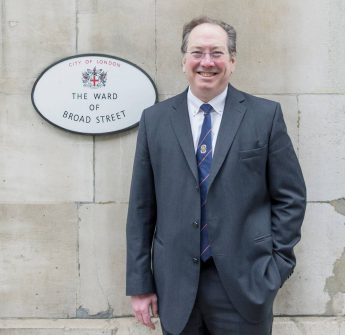Remarks to: Pollinating London Together, Worshipful Company of Wax Chandlers & others, 16 September 2021, Mansion House, by Alderman & Sheriff Professor Michael Mainelli.
Lady Mayoress, Masters, Aldermen, Ladies & Gentlemen:
As a teenager, I worked in a family bee business with some 300 hives at one point. I was delighted as I rode by Drapers’ Hall yesterday, on my Ride Round The Range with seven of the HAC Light Cavalry and two police horses to go through my ward of Broad Street. One of the most entrepreneurial wards where, earlier this year, one of our cannabis businesses was shut down, otherwise the two hives on the roof of Mansion House might be famous for some infused products.
It is heartening to see the support today for a serious discussion on biodiversity. I needn’t draw your attention to the scale of the problem, I needn’t tug your heartstrings, I needn’t emphasise the importance of the issue.
The comedian Jay Leno once quipped, “According to a new UN report, the global warming outlook is much worse than originally predicted. Which is pretty bad when they originally predicted it would destroy the planet.” Sadly, that quip was from 2007.
I have been asked to address the fact that in a world where it is starting to be accepted that the natural environment has, or should have, a value what are the economic tools that might be used to encourage individuals and corporations to give greater consideration to protecting biodiversity.
I appreciate this type of cross-pollination, finance and biodiversity. So what I would like to do in my short pitch is to consider:
- Economics and biodiversity;
- Look at what financial mechanisms don’t work;
- Look at what financial mechanisms might work.
Economics & Biodiversity
Some of you will know that I wrote a book a decade ago called “The Price of Fish – A New Approach To Wicked Economics & Better Decisions”. I drew on experience developing the Marine Stewardship Council for sustainable wild fishing. We had significant problems with slow growing fish such as orange roughy and bahaba, the giant yellow croaker. Jeffrey Sachs, Common Wealth: Economics for a Crowded Planet, Allen Lane (2008), page 40, explains:
“Two subtle issues are at work in this example [of the market price of fish]. The first is that the market price of a species will generally not reflect the species’ societal value as part of Earth’s biodiversity. Market prices do not reflect the value that society puts on avoiding the extinction of other species, only on the direct consumption value of those species (for food, aphrodisiacs, pets, hunting trophies, or ornaments). Second, the rate of interest diminishes the incentive for the resource owner to harvest the resource at a sustainable rate. If the value of the resource is likely to grow more slowly than the market rate of interest, the blaring market signal is to deplete the resource now and pocket the money! Since the market rate of interest depends ultimately on the saving decisions and preferences of the current generation alone, without any voice of the future generations, the market rate of interest can give the signal to deplete the resource at the expense of future generations. When the current generation is impatient, that is, it places a high value on current consumption relative to future consumption, the market interest rate will tend to be high and the market signal transmitted to each individual resource owner will be to deplete the resources under the owner’s control. In essence, there is a tyranny of the present over the future.
As expected from the theory, slower-growing animals and plants are especially endangered today. Consider as an example one major category: slow-growing megafish. Their slow growth makes them a “poor investment” even in managed fisheries, and their large size makes them an easy prey…”
For those of a non-technical nature, it may be interesting to note that biologists and others discuss biodiversity measurement in great depth. Simpson indices, Shannon indices, Emergy analysis, and other approaches try to reflect different values for ecosystems such as rain forest, savanna, desert, grassland, coniferous forest, boreal forest, tundra, or even coral reefs.
What many financial people are unaware of is that we analysts have borrowed biologists’ indices to measure economic diversity. I use such Shannon indices to measure how rich is the economic variety of cities when constructing my Global Financial Centres Index, regulators use such measures to look at market competitiveness. This is a good example for today of cross-pollination.
There are many problems with such indices though. As with all measures, there can be unintended consequences. What are you trying to maximise? The amount of species per area or volume? The megafauna or megaflora? How pretty things are? How dangerous? Which is more important, arctic foxes on tundra, or sharks cruising the Great Barrier Reef?
What Mechanisms Don’t Work
Great work has been done on valuation, much of it heroic, such as The Economics of Ecosystems and Biodiversity (TEEB), Standford University’s Integrated Valuation of Ecosystem Services and Tradeoffs (InVEST), or the UK Treasury’s Dasgupta Review. Yet I take issue with a few valuation mechanisms. There has been some great work here, but it often leads to a single number being chosen for the value of life on earth, or an ecosystem. Using a market approach for the entire value needs a market. If we sell the earth for $400tn, where are we going to buy a new planet to move onto instead? By way of comparison, perhaps we could place a market value on one of your kidneys, assuming you have two, but would you feel comfortable with me as I place a market value on your heart or brain?
A decade ago, at Guildhall over several months, the London Accord released three reports with the National Environmental Research Council on finance and forestry, water, and biodiversity. Forestry was quite amenable to financial and economic approaches, and some of you will know of the extensive work we have done for the global Programme for the Endorsement of Forestry Certification. Water, much less so; 250 major river basins cross national boundaries and groundwater reservoirs are neither aligned with nor confined to national borders. And water is mostly too heavy to trade.
On biodiversity though, concepts such as ecosystem service payments remain very local. Very very local. The City of London Corporation and KPMG brought out a report two months ago, entitled, “The International Trade In Environmental Services: Barriers To Trade And Recent Approaches To Liberalisation”. In a surprising difference from such reports just a decade ago, in 40 pages there isn’t a single mention of biodiversity services. Biodiversity isn’t tradable.
In my opinion, the only way to support biodiversity is the protection of raw land and sea, through set-asides. The wetlands of the east coast of America seem to holding up due to reserves and set-aside lands which have multiplier offsets of similar or higher quality. Build a new golf course? Sure, but put two golf courses worth of land into set-aside. Marine exclusion zones and sanctuaries appear to work, from whales to reefs, even to benefit neighboring commercial exploitation. Elephant corridors seem to work. Exclusion zones can include innovative ideas such as urban bee corridors connecting nature reserves.
That said, I do sympathise with Canadian environmentalist Dr David Suzuki’s objection that, “the famous Brundtland Commission report Our Common Future which came out in 1987 coined the phrase ‘sustainable development’ and called for the protection of 12% of the land in all countries, a target which has absolutely no scientific basis and yet which very few countries have managed to achieve. But we are one species out of 15-30 million species on the planet and setting a target of protection of 12% of our land base for all the other species means that we seem to take it for granted that we can take over 88% of the land.” Density is an important consideration in providing space for biodiversity.
What Financial Mechanisms Might Work
Portfolio diversity protects your pension, by spreading your investments around, thus avoiding a single catastrophic failure. Biodiversity is related to financial concepts of portfolio diversity, but more complex. Unlike a financial portfolio, as mentioned before, going to zero is worse than broke, it means death. The components in the portfolio have huge, unnoticed correlations well beyond financial analysis of alpha and beta.
Here’s one approach to valuing biodiversity that is overlooked in many analyses. Biodiversity reduces volatility and thus increases certainty. That is precisely why the 1973 Black-Scholes option pricing equation was created, to put a value on increased certainty from financial derivatives. We have used option theory approaches successfully, for example twenty years ago on wild Alaskan salmon. This can work well if there is a commercial commodity market.
Moving up a level, biodiversity portfolios reduce volatility for society. Wetlands absorb tidal surges. Forests clean air or reduce heat wave effects. Ground cover purifies water. Marine sanctuaries around windfarms protect energy investments yet also reinvigorate marine life.
We’re learning that technical costing approaches just create analytical work to little effect. We need simple mechanisms. On carbon, more than ESG analysis we should enforce strong carbon market coverage, as China joined the EU in doing so this year.
On biodiversity we can deploy the simple mechanisms of hard set-asides and reserves, but with taxes based on their contribution to reducing economic and social volatility. Forms of land value tax might help. We can set tax rates using option theory. And we’re facing some of those decisions now. Take the local issue of the Thames Barrier replacement. Option theory has a role in evaluating an engineering replacement for the Barrier versus much more extensive use of set-aside lands in Kent and Essex.
We’re learning that set-asides are probably the best way to sustain biodiversity, though the sheer scale we need to set-aside hasn’t truly been recognised. “In the 146 years since Yellowstone National Park in the northwestern United States became the world’s first protected area, nations around the world have created more than 200,000 terrestrial nature reserves. Together they cover more than 20 million km², or almost 15% of the planet’s land surface – an area bigger than South America.” But on inspection only 42% of this protected land is found to be free of measurable human pressure, so we’re really only just over halfway to our arbitrary 12% target.
So far, we’ve failed to find a way to make biodiversity pay as a financial investment. Yet we do have the ways to calculate what it’s worth, and hard mechanisms to get there. So the question is, do we as society want to enforce hard set-asides and steep payment. Or do we just like the paperwork of ESG. I’m optimistic though. Pessimism is for better times.
Thank you.
Read more.

